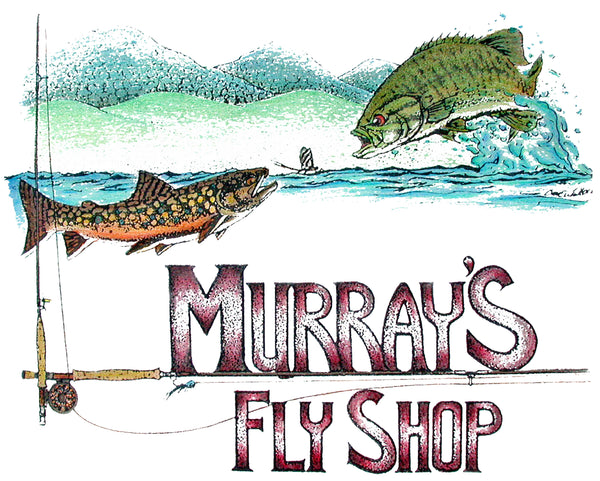Virginia's Ten Best Flies for Trout and Bass
The Virginia Department of Game and Inland Fisheries asked me to make up an assortment of Virginia's Ten Best Trout Flies and Virginia's Ten Best Bass Flies which would be productive over the whole state. In the years since I first developed these assortments I've had customers and friends tell me these flies are exceptionally effective for them all across the country.
My goal in working up these assortments was to select flies that either matched the natural foods the fish feed upon or that have proved themselves to have great fish appeal. Below are the top ten trout flies and top ten bass flies with the techniques to fish them.
Top Ten Trout Flies
-
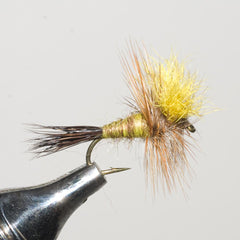 The Mr. Rapidan Dry Fly size 14 is by far my favorite and most productive dry fly. This fly has an interesting origin. About 20 years ago I was teaching a fly fishing/flytying class at Lord Fairfax Community College when two of the older gentlemen in my class came to me with a special request. "Teach us how to tie a dry fly that floats like a cork, that we can see on the stream and that matches the most important aquatic insect hatches." Thus the Mr. Rapidan Dry Fly was born. Today it is the number one selling fly in my fly shop and I have expanded the Mr. Rapidan family. I fish this upstream dead drift to the rising trout when the Eperous pleuralis, Stenonema vicarium and Baetis hatches are on. If the hatches are sparse I just use it to cover all of the possible feeding stations. I fish these on a Classic 9ft 5X Leader.
The Mr. Rapidan Dry Fly size 14 is by far my favorite and most productive dry fly. This fly has an interesting origin. About 20 years ago I was teaching a fly fishing/flytying class at Lord Fairfax Community College when two of the older gentlemen in my class came to me with a special request. "Teach us how to tie a dry fly that floats like a cork, that we can see on the stream and that matches the most important aquatic insect hatches." Thus the Mr. Rapidan Dry Fly was born. Today it is the number one selling fly in my fly shop and I have expanded the Mr. Rapidan family. I fish this upstream dead drift to the rising trout when the Eperous pleuralis, Stenonema vicarium and Baetis hatches are on. If the hatches are sparse I just use it to cover all of the possible feeding stations. I fish these on a Classic 9ft 5X Leader. -
 The Mr. Rapidan Bead Head Nymph size 14 was developed to match the underwater forms of several mayflies. It is very effective fished upstream dead drift below the riffles and along the sides of the incoming riffles all season. In order to help detect these strikes I use a Trout Nymphing Leader which has two Scientific Anglers indicators built into the leader.
The Mr. Rapidan Bead Head Nymph size 14 was developed to match the underwater forms of several mayflies. It is very effective fished upstream dead drift below the riffles and along the sides of the incoming riffles all season. In order to help detect these strikes I use a Trout Nymphing Leader which has two Scientific Anglers indicators built into the leader. -
 The Mr. Rapidan Delta Wing Caddis, Olive size 14 is very effective on many streams for most of the season because it effectively matches many different caddisfly hatches. I fish this upstream dead drift to rising trout or with a slight twitching action if there are not many rising trout.
The Mr. Rapidan Delta Wing Caddis, Olive size 14 is very effective on many streams for most of the season because it effectively matches many different caddisfly hatches. I fish this upstream dead drift to rising trout or with a slight twitching action if there are not many rising trout. -
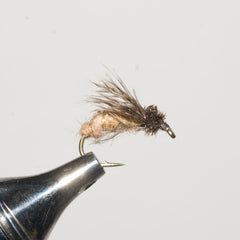 The Murray's Caddis Pupa, Tan is extremely effective when fished on a 2 foot 5X dropper below the Mr. Rapidan Delta Wing Caddis, Olive Dry. Frequently the natural caddis pupa will drift downstream several feet just below the surface before emerging into the adult. It also produces many trout when fished upstream along the stream bottom with a slow lifting action.
The Murray's Caddis Pupa, Tan is extremely effective when fished on a 2 foot 5X dropper below the Mr. Rapidan Delta Wing Caddis, Olive Dry. Frequently the natural caddis pupa will drift downstream several feet just below the surface before emerging into the adult. It also produces many trout when fished upstream along the stream bottom with a slow lifting action. -
 The Murray's Dark Stonefly Nymph size 12 is effective all season on mountain trout streams when fished upstream to drift back along the stream bottom in the deep pools. On large trout streams you can catch many trout with it by casting it across stream right below the riffles and twitching it along the stream bottom as the current pushes it downstream.
The Murray's Dark Stonefly Nymph size 12 is effective all season on mountain trout streams when fished upstream to drift back along the stream bottom in the deep pools. On large trout streams you can catch many trout with it by casting it across stream right below the riffles and twitching it along the stream bottom as the current pushes it downstream. -
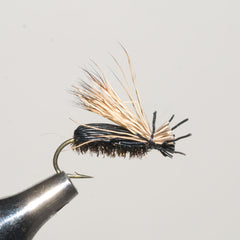 The Murray's Flying Beetle size 14 is my favorite fly once the major hatches are sparse. This means that from June until fall this is the fly with which I start. There are over 200 beetle-type insects along our trout streams so it is easy to see why the trout take it so readily. In most cases I fish this upstream dead drift on 6X whether I'm fishing to rising trout or just covering the water. One trick that often fools a large tough trout that has come up to look at several of your flies but refused all of them is a "splash presentation". Here I present the Flying Beetle with an extra snap on the presentation cast so it lands 2 feet to the side of the trout's tail with a splash. Often he will turn and take it right away.
The Murray's Flying Beetle size 14 is my favorite fly once the major hatches are sparse. This means that from June until fall this is the fly with which I start. There are over 200 beetle-type insects along our trout streams so it is easy to see why the trout take it so readily. In most cases I fish this upstream dead drift on 6X whether I'm fishing to rising trout or just covering the water. One trick that often fools a large tough trout that has come up to look at several of your flies but refused all of them is a "splash presentation". Here I present the Flying Beetle with an extra snap on the presentation cast so it lands 2 feet to the side of the trout's tail with a splash. Often he will turn and take it right away. -
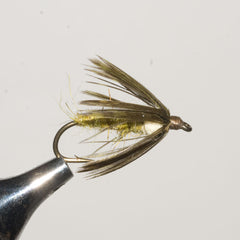 The Mr. Rapidan Soft Hackle, Olive size 14 is an outstanding searching fly that I use to cover the water when nothing in particular is hatching. Its fuzzy body and soft pulsating hackle make it act like something good to eat. On large streams I fish it across stream with a slow twitching action. On small streams I fish it upstream with a slow 6 inch lifting and dropping action.
The Mr. Rapidan Soft Hackle, Olive size 14 is an outstanding searching fly that I use to cover the water when nothing in particular is hatching. Its fuzzy body and soft pulsating hackle make it act like something good to eat. On large streams I fish it across stream with a slow twitching action. On small streams I fish it upstream with a slow 6 inch lifting and dropping action. -
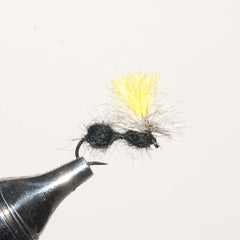 The Mr. Rapidan Ant size 16 is the fly I go to when the trout refuse all of my normal offerings. There are so many natural ants along our streams throughout the whole season that the trout are accustomed to feeding on the naturals and they take this fly quickly.
The Mr. Rapidan Ant size 16 is the fly I go to when the trout refuse all of my normal offerings. There are so many natural ants along our streams throughout the whole season that the trout are accustomed to feeding on the naturals and they take this fly quickly. -
 The Murray's Marauder, Black size 12 streamer matches many of the dark colored minnows in our trout streams. On large streams I fish this across stream with a slow swimming action by stripping it six inches every ten seconds. On small streams I fish it upstream and use a slow rod-lifting action every ten seconds to swim it back downstream.
The Murray's Marauder, Black size 12 streamer matches many of the dark colored minnows in our trout streams. On large streams I fish this across stream with a slow swimming action by stripping it six inches every ten seconds. On small streams I fish it upstream and use a slow rod-lifting action every ten seconds to swim it back downstream. -
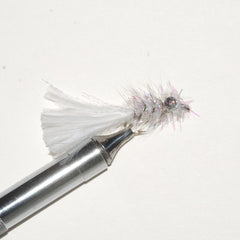 The Murray's Marauder, Pearl size 10 streamer matches many light colored minnows which are present in all trout streams. Some of these minnows are found in schools in the shallows in large trout streams. An effective fishing technique is to wade downstream 30 feet out from the bank and cast the Pearl Marauder in close to the bank and strip it slowly out toward the deep water. When fishing the small streams with the Pearl Marauder I like to cast it upstream and swim it back downstream by stripping it slightly faster than the current is pushing it.
The Murray's Marauder, Pearl size 10 streamer matches many light colored minnows which are present in all trout streams. Some of these minnows are found in schools in the shallows in large trout streams. An effective fishing technique is to wade downstream 30 feet out from the bank and cast the Pearl Marauder in close to the bank and strip it slowly out toward the deep water. When fishing the small streams with the Pearl Marauder I like to cast it upstream and swim it back downstream by stripping it slightly faster than the current is pushing it.
Top Ten Bass Flies
-
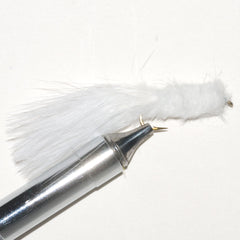 The Shenk's White Streamer in size 6 matches the chub minnows which are found in many bass rivers. An effective technique is to wade into the river 100 feet downstream of the riffles. The first cast is 40 feet long across stream. After the fly sinks deeply swim it slowly across stream by stripping it 6 inches with your line hand every 10 seconds. Successive casts are made 5 feet longer until you are casting as long as you are comfortable. Each of these cast is stripped back across stream just as you did on the first cast. Wade downstream pausing every 10 feet to repeat this tactic until you reach the shallow water in the tail of the pool and you catch many bass.
The Shenk's White Streamer in size 6 matches the chub minnows which are found in many bass rivers. An effective technique is to wade into the river 100 feet downstream of the riffles. The first cast is 40 feet long across stream. After the fly sinks deeply swim it slowly across stream by stripping it 6 inches with your line hand every 10 seconds. Successive casts are made 5 feet longer until you are casting as long as you are comfortable. Each of these cast is stripped back across stream just as you did on the first cast. Wade downstream pausing every 10 feet to repeat this tactic until you reach the shallow water in the tail of the pool and you catch many bass. -
 The Murray's Heavy Hellgrammite, Black size 6 was a fly the late Charlie Brooks helped me develop. By picking up stones from the stream bottom and removing the real hellgrammites and dropping them one by one into the river and watching them closely I discovered the action I needed to produce with my fly in order to catch the bass. These real hellgrammites did not simply sink to the stream bottom but most of them swam with a very pronounced undulating action as they angled downstream to the stream bottom. After years of testing many different materials and styles of tying it I came up with the Murray's Heavy Hellgrammite as we know it today and it is much more effective than the earlier patterns. In order to mimic this realistic motion of the real hellgrammites there are two different techniques which are productive. Large populations of natural hellgrammites are found in the riffles so I have the students in my bass schools wade into the downstream edge of the riffles and cast straight across stream. After the fly sinks deeply swim it along the boulders by stripping it 2 inches every 6 seconds all the way back across stream. Using gradually longer casts and wading downstream you will catch many bass with this method. The second technique which is effective with the Murray's Heavy Hellgrammite is the upstream dead drifting method. By wading upstream through the riffles and casting upstream so your Hellgrammite drifts into the 3 to 4 foot deep pockets you are drifting it directly into their feeding stations. By using the Murray's Bright Butt 9ft 2X Leader with two Scientific Anglers indicators spaced along it, you can quickly see the strike and hook the bass. Wading upstream through the riffles and fishing all of the deep areas with this method is great fun and very effective.
The Murray's Heavy Hellgrammite, Black size 6 was a fly the late Charlie Brooks helped me develop. By picking up stones from the stream bottom and removing the real hellgrammites and dropping them one by one into the river and watching them closely I discovered the action I needed to produce with my fly in order to catch the bass. These real hellgrammites did not simply sink to the stream bottom but most of them swam with a very pronounced undulating action as they angled downstream to the stream bottom. After years of testing many different materials and styles of tying it I came up with the Murray's Heavy Hellgrammite as we know it today and it is much more effective than the earlier patterns. In order to mimic this realistic motion of the real hellgrammites there are two different techniques which are productive. Large populations of natural hellgrammites are found in the riffles so I have the students in my bass schools wade into the downstream edge of the riffles and cast straight across stream. After the fly sinks deeply swim it along the boulders by stripping it 2 inches every 6 seconds all the way back across stream. Using gradually longer casts and wading downstream you will catch many bass with this method. The second technique which is effective with the Murray's Heavy Hellgrammite is the upstream dead drifting method. By wading upstream through the riffles and casting upstream so your Hellgrammite drifts into the 3 to 4 foot deep pockets you are drifting it directly into their feeding stations. By using the Murray's Bright Butt 9ft 2X Leader with two Scientific Anglers indicators spaced along it, you can quickly see the strike and hook the bass. Wading upstream through the riffles and fishing all of the deep areas with this method is great fun and very effective. -
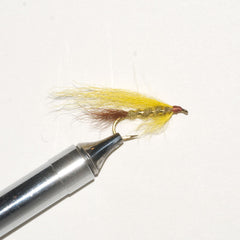 The Mr. Rapidan Streamer size 6 is a good match for many sunfish and it can easily match their natural swimming action. From May until fall many small sunfish make their homes in the knee deep water over cobblestone stream bottoms along the river banks and the tails of the islands. By wading or floating these areas and casting the Mr. Rapidan Streamer tight in against the banks and stripping it out very slowly you will often catch some large bass before your streamers gets 5 feet from the bank. Back in the days of live bait fishing for bass the small sunfish were very popular baits. However, I don't believe they were legal baits even in those days.
The Mr. Rapidan Streamer size 6 is a good match for many sunfish and it can easily match their natural swimming action. From May until fall many small sunfish make their homes in the knee deep water over cobblestone stream bottoms along the river banks and the tails of the islands. By wading or floating these areas and casting the Mr. Rapidan Streamer tight in against the banks and stripping it out very slowly you will often catch some large bass before your streamers gets 5 feet from the bank. Back in the days of live bait fishing for bass the small sunfish were very popular baits. However, I don't believe they were legal baits even in those days. -
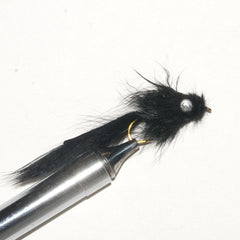 Murray's Madtom Sculpin, Black size 6. The natural madtoms and sculpins are not schooling minnows but great numbers of these make their homes under the stones on the bottom of the riffles. When I was a kid we used to seine sculpins in the riffles to use for live bait. I would hold the seine stretched between two broom handles close to the stream bottom and you would go 5 feet upstream and vigorously stir the stream bottom with an old broom handle. In just a few minutes we would have enough sculpin minnows to use for bait all day. An effective way to fish these riffles with the Murray's Madtom Sculpin is to wade into the side of the river right below the riffle and cast straight across stream. I let it sink deeply then swim it along the stones and boulders by stripping it 6 inches every 5 seconds. If the current is quite fast I use a Sink Tip III line in order to fish my streamer deeply. The natural madtoms, which look like baby catfish, are often found below the stones in the tails of the pools. They come out very late in the evening to feed---we used to seine these at night. The bass cruise the tails of the pools at dusk and quickly grab the natural madtoms as they come out to feed. I fish this set-up by wading into the tails of the pools at dusk and fanning my casts with the Murray's Madtom Sculpin across all of the water I can reach as I wade slowly upstream.
Murray's Madtom Sculpin, Black size 6. The natural madtoms and sculpins are not schooling minnows but great numbers of these make their homes under the stones on the bottom of the riffles. When I was a kid we used to seine sculpins in the riffles to use for live bait. I would hold the seine stretched between two broom handles close to the stream bottom and you would go 5 feet upstream and vigorously stir the stream bottom with an old broom handle. In just a few minutes we would have enough sculpin minnows to use for bait all day. An effective way to fish these riffles with the Murray's Madtom Sculpin is to wade into the side of the river right below the riffle and cast straight across stream. I let it sink deeply then swim it along the stones and boulders by stripping it 6 inches every 5 seconds. If the current is quite fast I use a Sink Tip III line in order to fish my streamer deeply. The natural madtoms, which look like baby catfish, are often found below the stones in the tails of the pools. They come out very late in the evening to feed---we used to seine these at night. The bass cruise the tails of the pools at dusk and quickly grab the natural madtoms as they come out to feed. I fish this set-up by wading into the tails of the pools at dusk and fanning my casts with the Murray's Madtom Sculpin across all of the water I can reach as I wade slowly upstream. -
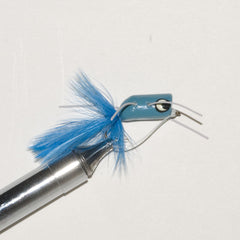 The Shenandoah Blue Popper size 6 is my favorite hard surface bug for the simple reason that is seldom lets me down. On many occasions I have been fishing other poppers with only fair results and switched to the Shenandoah Blue Popper and caught one bass after another. It is not just the color either, I believe the long tapered body with the gentle up-sloping face enables us to produce an action which the bass find appealing. Even on bright sunny days you can get great surface fishing with this bug by fishing the shaded banks. If you have hip-deep to chest-deep water over a cobblestone stream bottom below the thick shade of a large oak trees you can catch bass all day long there on the Shenandoah Blue Popper using a slow pull-pause-pull action. At dawn and dusk there is exciting action with this bug in the tails of the pools.
The Shenandoah Blue Popper size 6 is my favorite hard surface bug for the simple reason that is seldom lets me down. On many occasions I have been fishing other poppers with only fair results and switched to the Shenandoah Blue Popper and caught one bass after another. It is not just the color either, I believe the long tapered body with the gentle up-sloping face enables us to produce an action which the bass find appealing. Even on bright sunny days you can get great surface fishing with this bug by fishing the shaded banks. If you have hip-deep to chest-deep water over a cobblestone stream bottom below the thick shade of a large oak trees you can catch bass all day long there on the Shenandoah Blue Popper using a slow pull-pause-pull action. At dawn and dusk there is exciting action with this bug in the tails of the pools. -
 The Murray's Marauder, Olive size 6 frequently out-fishes many other streamers for reasons I can't explain. Some of my largest bass each year take this streamer when I fish it along the edges of the aquatic grassbeds with a slow darting action. When the rivers get low late in the summer I like to wade upstream and fish upstream so I don't scare the bass. The way I tie the Olive Marauder enables me to cast it upstream and swim it back downstream with a natural minnow action that apparently has great fish-appeal.
The Murray's Marauder, Olive size 6 frequently out-fishes many other streamers for reasons I can't explain. Some of my largest bass each year take this streamer when I fish it along the edges of the aquatic grassbeds with a slow darting action. When the rivers get low late in the summer I like to wade upstream and fish upstream so I don't scare the bass. The way I tie the Olive Marauder enables me to cast it upstream and swim it back downstream with a natural minnow action that apparently has great fish-appeal. -
 The Murray's Marauder, Pearl size 6 is an exceptionally versatile streamer. I catch many bass on this when I see them feeding on shiner minnows around grass beds and over shallow gravel bars. Bass often cruise the deep water right along the edges of the shallow gravel bars and feed on any shiner that stray off the gravel bars. It is also an excellent streamer to use as a searching pattern when you are floating the large pools. Many of these pools hold large numbers of creek chub minnows and the Murray's Pearl Marauder is a good match for this minnow. Be sure to swim this fly deeply between the river crossing ledges as you drift downstream. I also do well with this streamer fished deeply below the riffles in the heads of the pools.
The Murray's Marauder, Pearl size 6 is an exceptionally versatile streamer. I catch many bass on this when I see them feeding on shiner minnows around grass beds and over shallow gravel bars. Bass often cruise the deep water right along the edges of the shallow gravel bars and feed on any shiner that stray off the gravel bars. It is also an excellent streamer to use as a searching pattern when you are floating the large pools. Many of these pools hold large numbers of creek chub minnows and the Murray's Pearl Marauder is a good match for this minnow. Be sure to swim this fly deeply between the river crossing ledges as you drift downstream. I also do well with this streamer fished deeply below the riffles in the heads of the pools. -
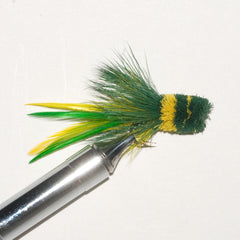 The Murray's Frisky Frog Deer Hair Bug size 4 is one of my favorite surface bugs to use from June until October. On flat sections of the river throughout the season and almost all of the river late in the season I like to wade upstream and fish upstream so I don't scare the bass. At these times I find that I catch more large bass if I make long casts. I like to fish on the surface and I find that I can cast this streamlined Frisky Frog 20% further than I can a popper. This gives me some of my largest bass when the streams get low and I fish this along the shaded banks.
The Murray's Frisky Frog Deer Hair Bug size 4 is one of my favorite surface bugs to use from June until October. On flat sections of the river throughout the season and almost all of the river late in the season I like to wade upstream and fish upstream so I don't scare the bass. At these times I find that I catch more large bass if I make long casts. I like to fish on the surface and I find that I can cast this streamlined Frisky Frog 20% further than I can a popper. This gives me some of my largest bass when the streams get low and I fish this along the shaded banks. -
 Murray's Crayfish size 6. Recently one of my guides was showing the students in our smallmouth school how to fish the Murray's Crayfish. On his second cast he hooked a 5 pound smallmouth. This quickly got the attention of his students. Dusk is my favorite time to fish crayfish. They just seem to like the low light levels. One day my son and I were floating the river in separate kick boats. I got to the take-out spot just before dark, 10 minutes before Jeff, so I just sat there in my boat with my feet resting on the stream bottom. I estimated that in those 10 minutes I saw over 100 crayfish scurrying about my feet on the stream bottom. My favorite way to fish the Murray's Crayfish is to wade down the river about 50 feet out from the river bank where the water along the bank is 3 to 4 feet deep over cobblestone stream bottoms. I cast my Crayfish right against the bank and after it sinks I strip it back with my line hand so it moves along the river bottom with a slow crawling action. I'm always amazed how many more bass I catch with my Crayfish the last hour of the day than I often do with streamers.
Murray's Crayfish size 6. Recently one of my guides was showing the students in our smallmouth school how to fish the Murray's Crayfish. On his second cast he hooked a 5 pound smallmouth. This quickly got the attention of his students. Dusk is my favorite time to fish crayfish. They just seem to like the low light levels. One day my son and I were floating the river in separate kick boats. I got to the take-out spot just before dark, 10 minutes before Jeff, so I just sat there in my boat with my feet resting on the stream bottom. I estimated that in those 10 minutes I saw over 100 crayfish scurrying about my feet on the stream bottom. My favorite way to fish the Murray's Crayfish is to wade down the river about 50 feet out from the river bank where the water along the bank is 3 to 4 feet deep over cobblestone stream bottoms. I cast my Crayfish right against the bank and after it sinks I strip it back with my line hand so it moves along the river bottom with a slow crawling action. I'm always amazed how many more bass I catch with my Crayfish the last hour of the day than I often do with streamers. -
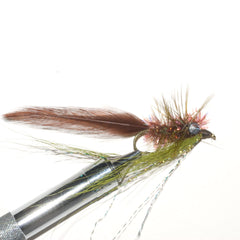 The Murray's Magnum Hog Sucker is a fly to use if you are after large bass. Recently I was wading down the middle of the North Fork of the Shenandoah River to fish the western bank. A splashing disturbance over a shallow gravel bar behind me attracted my attention and I looked back just in time to see a huge smallmouth grab a large hog sucker. I did not want to take time to tie on a Magnum Hog Sucker but that bass did not want the fly I showed him. My favorite way to fish the Magnum Hog Sucker is to wade or float down the river 50 feet out from where the shallow gravel bars along the sides of the river taper off into the deep water in the main river channels. I cast the streamer up on the shallow gravel bar and strip it slowly out into the deep water. The strike usually comes just as the fly enters the deep water. There are many sections of the rivers where the large bass cruise along these drop offs to feed on the hog sucker.
The Murray's Magnum Hog Sucker is a fly to use if you are after large bass. Recently I was wading down the middle of the North Fork of the Shenandoah River to fish the western bank. A splashing disturbance over a shallow gravel bar behind me attracted my attention and I looked back just in time to see a huge smallmouth grab a large hog sucker. I did not want to take time to tie on a Magnum Hog Sucker but that bass did not want the fly I showed him. My favorite way to fish the Magnum Hog Sucker is to wade or float down the river 50 feet out from where the shallow gravel bars along the sides of the river taper off into the deep water in the main river channels. I cast the streamer up on the shallow gravel bar and strip it slowly out into the deep water. The strike usually comes just as the fly enters the deep water. There are many sections of the rivers where the large bass cruise along these drop offs to feed on the hog sucker.
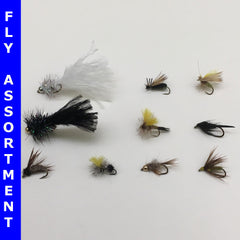
|
 |
Virginia's Ten Best Trout Flies Assortment |
Virginia's Ten Best Bass Flies Assortment |
-
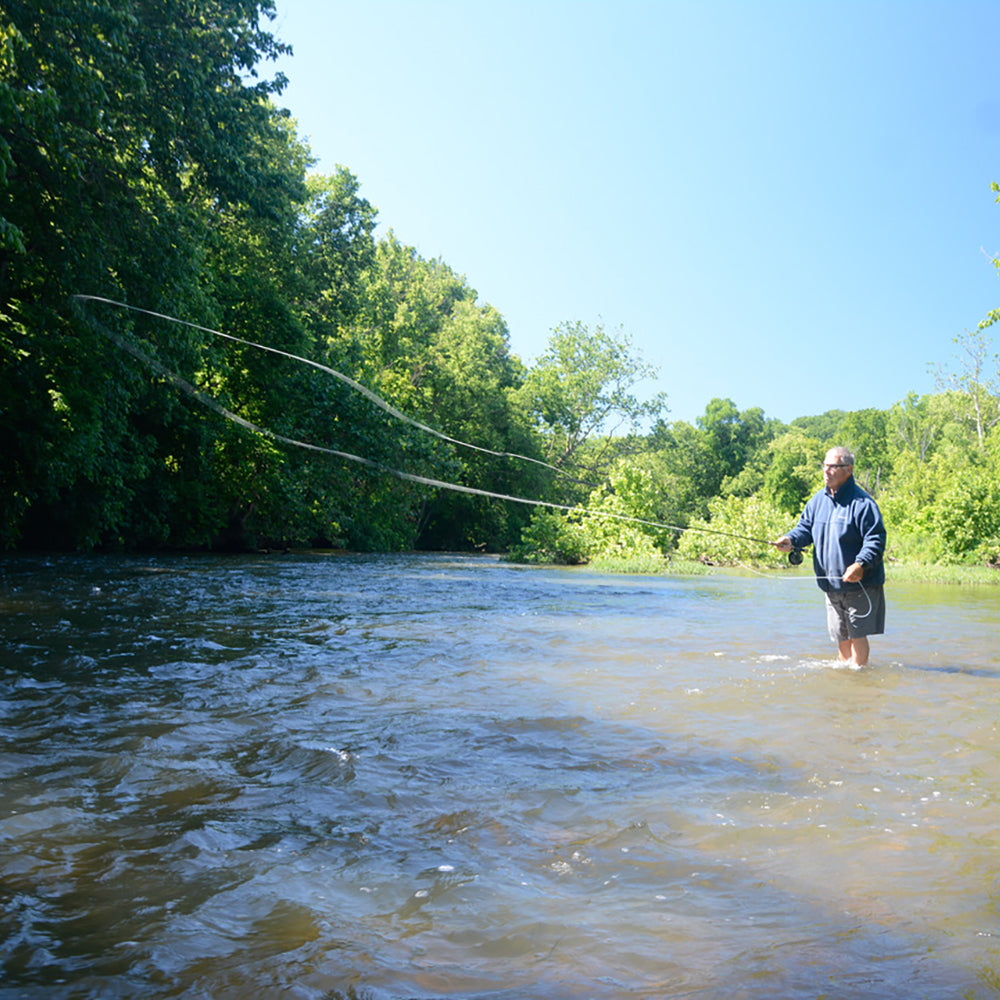
Learn Fly Fishing at Murray’s Fly Shop: Classes, Workshops & Schools
Welcome to Murray’s Fly Shop – Your Fly Fishing Learning Hub At...
-
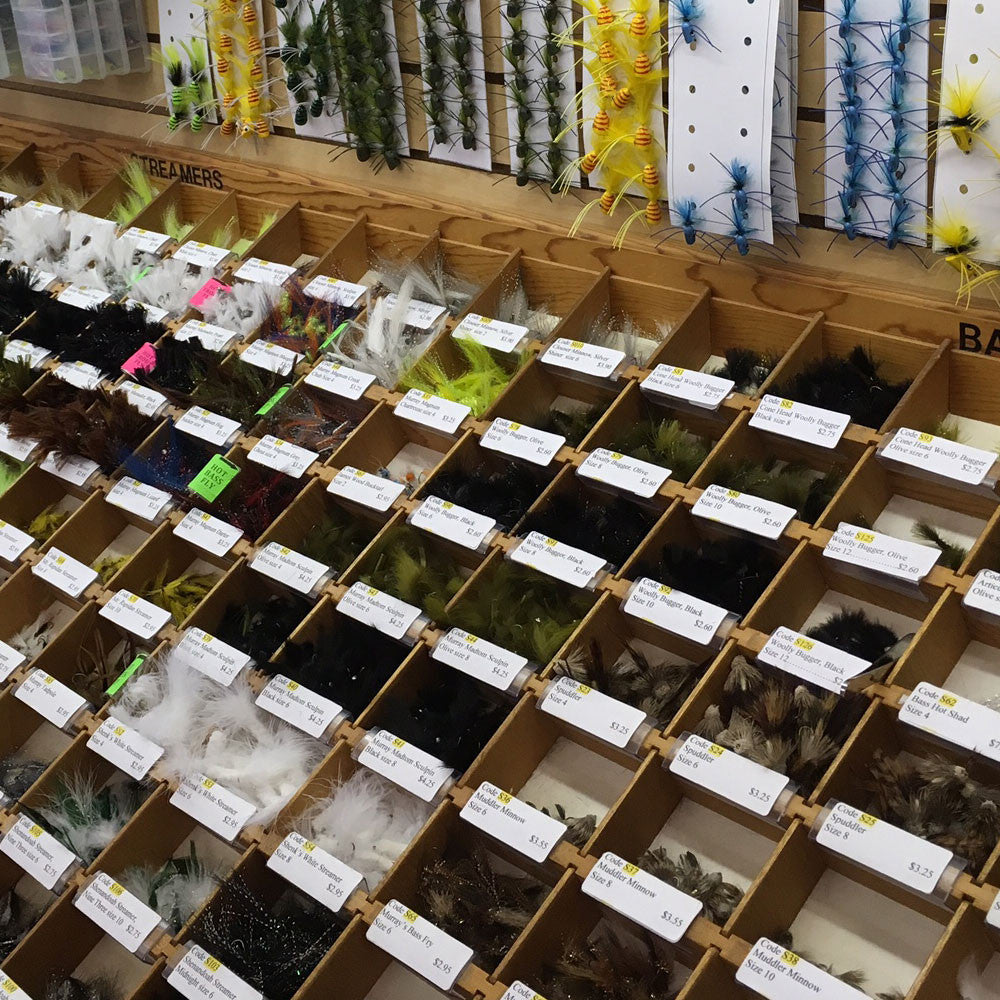
Featured Flies of the Month
Harry Murray's recommended fly list for this time of the year. (March...
-
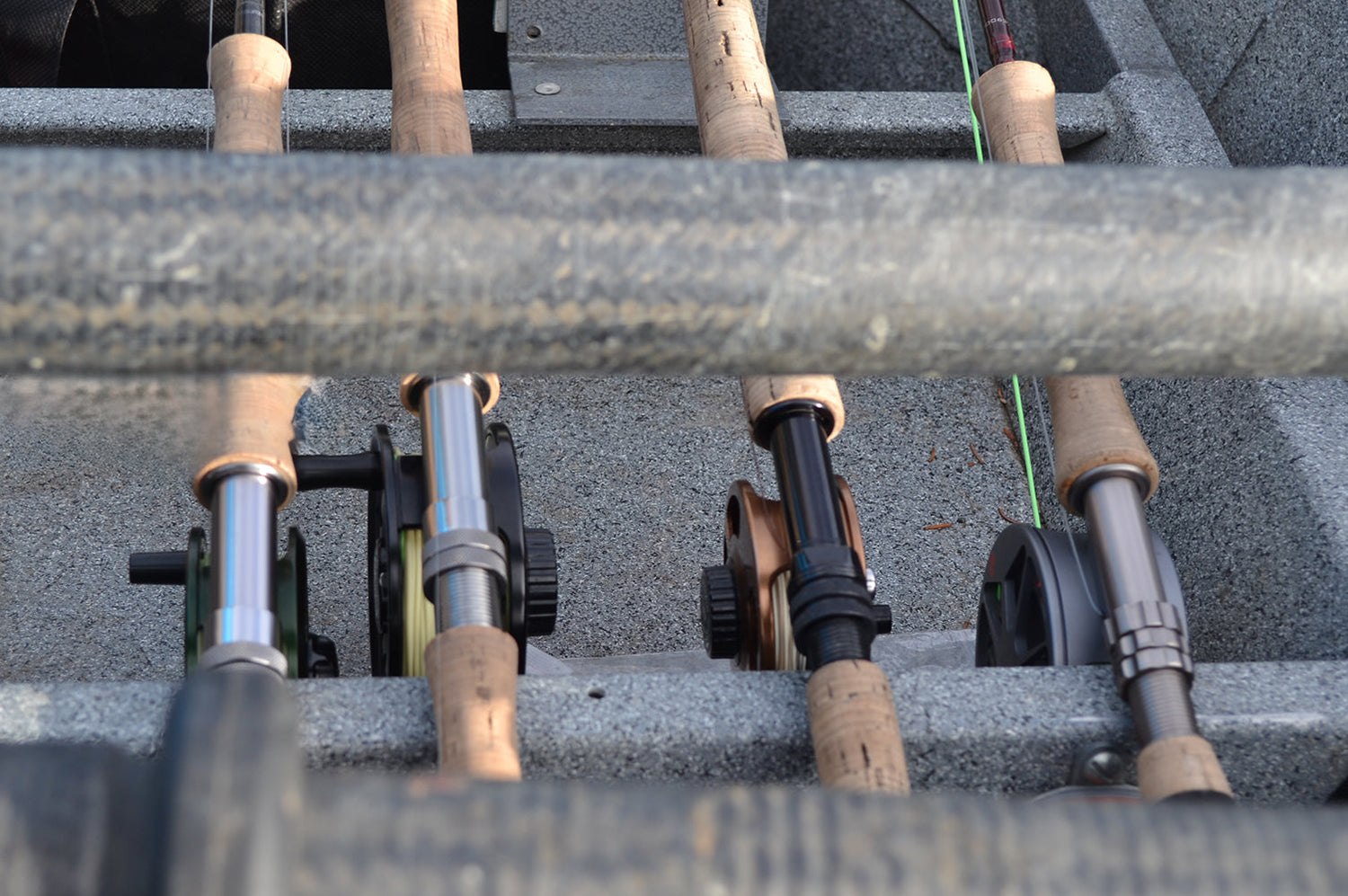
Fly Fishing Rod Outfits
Fly Fishing Rod and Reel Outfits for Smallmouth Bass fly fishing, Trout...
